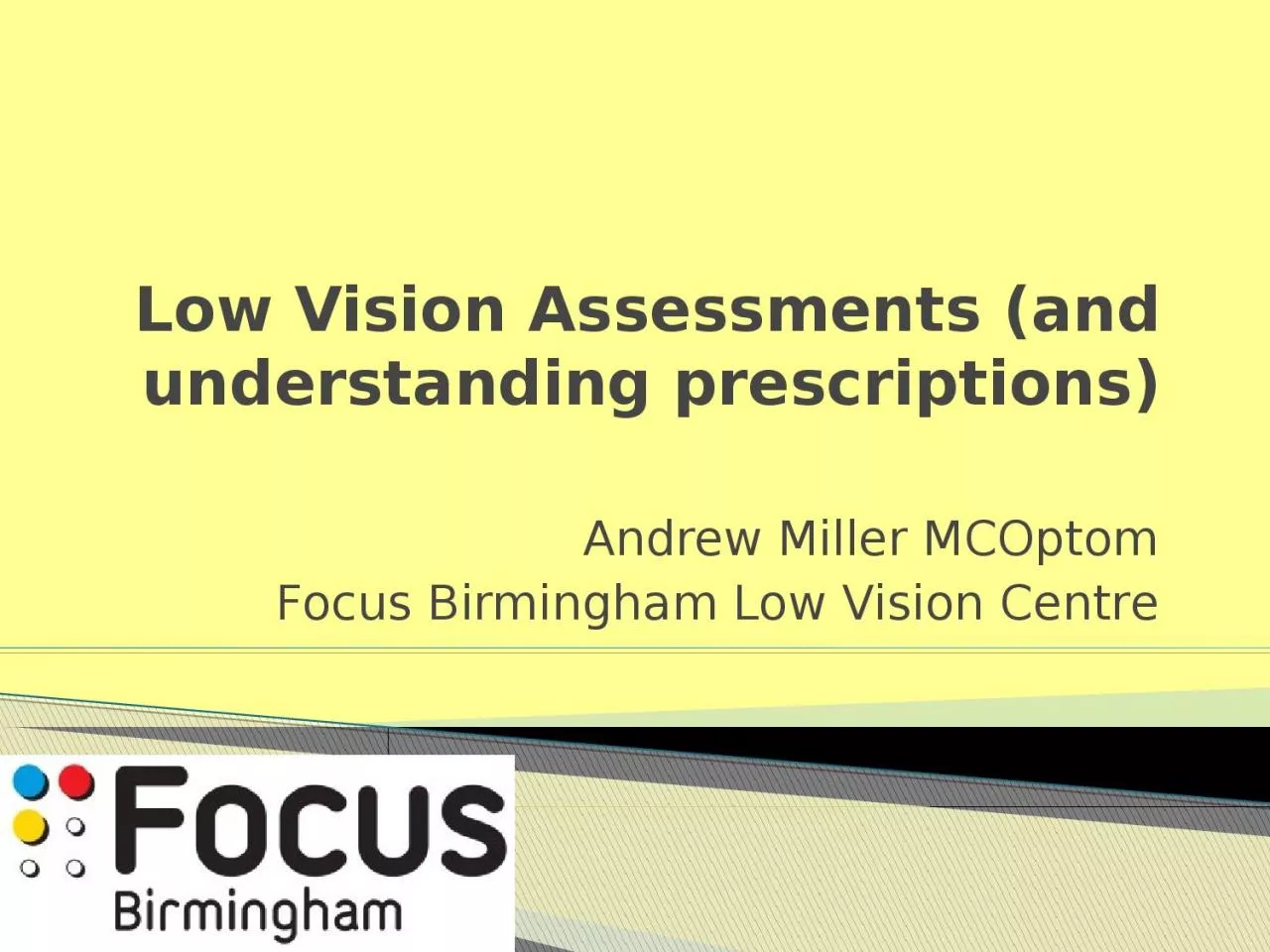

Andrew Miller MCOptom Focus Birmingham Low Vision Centre Spectacle Prescriptions What do the numbers mean What Is Low Vision Likely Problems Low Vision Assessment Aids Supplied Other Measurements ID: 929826
Download Presentation The PPT/PDF document "Low Vision Assessments (and understandin..." is the property of its rightful owner. Permission is granted to download and print the materials on this web site for personal, non-commercial use only, and to display it on your personal computer provided you do not modify the materials and that you retain all copyright notices contained in the materials. By downloading content from our website, you accept the terms of this agreement.
Slide1
Low Vision Assessments (and understanding prescriptions)
Andrew Miller MCOptomFocus Birmingham Low Vision Centre
Slide2Spectacle Prescriptions
What do the numbers mean What Is Low Vision Likely ProblemsLow Vision AssessmentAids Supplied
Other Measurements
Fields Contrast Sensitivity Function
What Am I Going To Tell You?
Slide3Understanding Prescriptions
Slide4Sphere (Sph)
Cylinder (Cyl)AxisAddBut Don’t Forget
Prism
BVD PD
Components To A Prescription
Slide5This tells Us How Long or Short Sighted You Are
Measured in dioptres (D) Often recorded as DS (+2.00DS)- means short-sighted+ means long-sighted0-4 low
4-10 moderate
10+ severe
Sphere
Slide6Myopia (Short-sightedness)
Slide7Hyperopia (longsighted)
Slide8Corrects AstigmatismNatural Distortion
Typically to the cornea (can be the lens) Cylinder and Axis
Slide9Correcting Astigmatism
Slide10Sphere (Sph)
Cylinder (Cyl)AxisAddBut Don’t Forget
Prism
BVD PD
Components To A Prescription
Slide11Corrects Presbyopia
Getting Old (usually age 45+)Lens HardensReading SpectaclesAdds will blur the Distance1/Add = working distance (m)
High Adds for Younger low vision potentially increase magnification.
Add
Slide12Prism
Change Position of ObjectDon’t affect focus
Used to Correct Binocular Problems
Prism Have a Power and DirectionUpDown
InOut
Slide13Pupillary Distance.
How far apart your eyes areInaccurate PD causes induced prism
PD and BVD
Slide14Back Vertex Distance
Measured in mm. Usually only important with bigger prescriptions
BVD
Slide15Why do we care?
If a +15.00 lens was prescribed to sit at 10mm slips down the nose to 15mm this changes the prescription by 0.75DSCAUTION changing BVD can help people read
BVD continued
Slide16Rx Summary
Slide17Any (Easy) Questions?
Slide18What Is a Low Vision Assessment
Andrew MillerLead Optometrist
Slide19Start with a definition..........
"A person with low vision is one who has an impairment of visual function for whom full remediation is not possible by conventional spectacles, contact lenses or medical intervention and which causes restriction in that person's everyday life". Low Vision Services Consensus Group (1999)
best-corrected visual acuity of worse than 6/18, but equal to or better than 3/60, or visual field of less than 20 degrees.”
WHOOr…
People who still can’t see, even when they have their spectacles on.
What
Slide20Aim
To improve the quality of life of the patient by enabling them to use their residual vision to its maximum potentialThe use of residual vision may be increased by the use of:
Aids
TrainingAdvice
HARD WORK Relies on the capacity for the individual to change and accept change
What Is A Low Vision Assessment
Slide21CompromiseAcceptance Denial
DepressionPhysical LimitationsLow Vision NOT NO VISIONEXPECTATIONS
What Are the Barriers?
Slide22“Magic”
“Cure”Patients get out what they put in As professional I need to Communicate Gain trustManage expectation
NO ONE DIED FROM A LOW VISION ASSESSMENT
What a low vision assessment is not.
Slide23Full Assessment of Need...LISTEN+++++Needs vary tremendously Important we address real need not the perceived need
No point giving a magnifier to someone who wants to bake a cakeToo often services can be tailored to what can be provided rather than what SU needs
What Is Involved in a Low Vision Assessment
Slide24Set realistic goals that the SU would like to achieve (discuss realism (flying a plane??) Patient’s Knowledge of eye condition
Full eye examinationCheck spectaclesCheck for treatable diseaseAssess the habitual position (lighting, aids, adaptations)
What Is Involved in a Low Vision Assessment
Slide25Estimate magnification needsTrial magnifying Aids and adaptations
Advice & TrainingReferral onto others Rehab/ mobility/ Emotional Support and Counselling (depression and isolation very common)
What Is Involved in a Low Vision Assessment
Slide26What Things Do We Recommend
Core with central eye disease is the three BsBIGGER, BOLDER , BRIGHTERToo much concentration on bigger
Lighting (most common advice/ most often ignored)
ContrastMagnifiers are most commonRange of types
Hand StandElectronic
Telescopes
Slide27Frequently:Brightfield
BinocularsMonocularsHand Mags
Hyperoculars
ElectronicLess Used
Spectacle MountedStand
Aids Used
Slide28ConsVariety of causes
of sight lossDon’t want to lookdifferentLack of compliance with aids
What Is Different With Children
Slide29ProsOften less co-morbidityAdaptable
ACCOMMODATIONAbility to flex lens inside the eye to bring near objects into focus
What Is Different With Children
Slide30Generally Bigger is BetterSimplest Magnifier
= hold something closer
Accommodation
Slide31Conclusion
Low vision assessment should be a comprehensive assessment of your needs.No magic curesAll avenues should be explored to help the problems identifiedNOT just giving out a magnifier